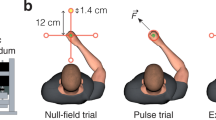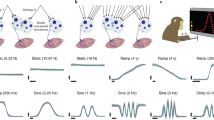Abstract
Several theories of motor control posit that the nervous system has access to a neural representation of muscle dynamics. Yet, this has not been tested experimentally. Should such a representation exist, it was hypothesized that subjects who learned to control a virtual limb using virtual muscles would improve performance faster and show greater generalization than those who learned with a less dynamically complex virtual force generator. Healthy adults practiced using their biceps brachii activity to move a myoelectrically controlled virtual limb from rest to a standard target position with maximum speed and accuracy. Throughout practice, generalization was assessed with untrained target trials and sensitivity to actuator dynamics was probed by unexpected actuator model switches. In a muscle model subject group (n = 10), the biceps electromyographic signal activated a virtual muscle that pulled on the virtual limb with a force governed by muscle dynamics, defined by a nonlinear force–length–velocity relation and series elastic stiffness. A force generator group (n = 10) performed the same task, but the actuation force was a linear function of the biceps activation signal. Both groups made significant errors with unexpected actuator dynamics switches, supporting task sensitivity to actuator dynamics. The muscle model group improved performance as fast as the force generator group and showed greater generalization in early practice, despite using an actuator with more complex dynamics. These results are consistent with a preexisting neural representation of muscle dynamics, which may have offset any learning challenges associated with the more dynamically complex virtual muscle model.









Similar content being viewed by others
References
Akaike H (1974) A new look at the statistical model identification. IEEE Trans Autom Control 19:716–723
An K, Ueba Y, Chao E, Cooney W, Linscheid R (1983) Tendon excursion and moment arm of index finger muscles. J Biomech 16:419–425
Armstrong B, de Wit CC (1996) Friction modeling and compensation. In: The control handbook, vol 77, pp 1369–1382
Asmussen E, Bonde-Petersen F (2008) Storage of elastic energy in skeletal muscles in man. Acta Physiol Scand 91:385–392
Atkeson CG (1989) Learning arm kinematics and dynamics. Ann Rev Neurosci 12:157–183
Bahler AS (1967) Series elastic component of mammalian skeletal muscle. Am J Physiol 213:1560–1564
Brainard DH (1997) The psychophysics toolbox. Spat Vis 10:433–436
Brown IE, Loeb GE (1999) A reductionist approach to creating and using neuromusculoskeletal models. In: Winters J, Crago P (eds) Biomechanics and neural control of movement. Springer-Verlag, New York, pp 148–163
Caithness G, Osu R, Bays P et al (2004) Failure to consolidate the consolidation theory of learning for sensorimotor adaptation tasks. J Neurosci 24:8662–8671
Cavagna GA (1977) Storage and utilization of elastic energy in skeletal muscle. Exerc Sport Sci Rev 5:89–130
Cheng EJ, Loeb GE (2008) On the use of musculoskeletal models to interpret motor control strategies from performance data. J Neural Eng 5:232
Conditt MA, Gandolfo F, Mussa-Ivaldi FA (1997) The motor system does not learn the dynamics of the arm by rote memorization of past experience. J Neurophysiol 78:554–560
de Rugy A, Loeb GE, Carroll TJ (2012) Muscle coordination is habitual rather than optimal. J Neurosci 32:7384–7391
Dingwell JB, Mah CD, Mussa-Ivaldi FA (2002) Manipulating objects with internal degrees of freedom: evidence for model-based control. J Neurophysiol 88:222–235
Donchin O, Francis JT, Shadmehr R (2003) Quantifying generalization from trial-by-trial behavior of adaptive systems that learn with basis functions: theory and experiments in human motor control. J Neurosci 23:9032–9045
Edman K, Elzinga G, Noble M (1978) Enhancement of mechanical performance by stretch during tetanic contractions of vertebrate skeletal muscle fibres. J Physiol 281:139–155
Edman K, Caputo C, Lou F (1993) Depression of tetanic force induced by loaded shortening of frog muscle fibres. J Physiol 466:535–552
Erdemir A, McLean S, Herzog W, van den Bogert AJ (2007) Model-based estimation of muscle forces exerted during movements. Clin Biomech 22:131–154
Feldman AG (1966) Functional tuning of the nervous system with control of movement or maintenance of a steady posture, II: controllable parameters of the muscles. Biophysics 11:565–578
Fellows S, Rack P (1987) Changes in the length of the human biceps brachii muscle during elbow movements. J Physiol 383:405–412
Flanagan JR, Wing AM (1997) The role of internal models in motion planning and control: evidence from grip force adjustments during movements of hand-held loads. J Neurosci 17:1519–1528
Gandolfo F, Mussa-Ivaldi F, Bizzi E (1996) Motor learning by field approximation. Proc Natl Acad Sci 93:3843–3846
Gerritsen KG, van den Bogert AJ, Hulliger M, Zernicke RF (1998) Intrinsic muscle properties facilitate locomotor control—a computer simulation study. Mot Control 2:206–220
Gordon KE, Ferris DP (2004) Proportional myoelectric control of a virtual object to investigate human efferent control. Exp Brain Res 159:478–486
Gordon A, Huxley AF, Julian F (1966) The variation in isometric tension with sarcomere length in vertebrate muscle fibres. J Physiol 184:170–192
Gordon AM, Forssberg H, Iwasaki N (1994) Formation and lateralization of internal representations underlying motor commands during precision grip. Neuropsychologia 32:555–568
Hall E, Flament D, Fraser C, Lemon R (1990) Non-invasive brain stimulation reveals reorganised cortical outputs in amputees. Neurosci Lett 116:379–386
Hasson CJ, Caldwell GE (2012) Effects of age on mechanical properties of dorsiflexor and plantarflexor muscles. Ann Biomed Eng 40:1088–1101
Hasson CJ, Shen T, Sternad D (2012) Energy margins in dynamic object manipulation. J Neurophysiol 108:1349–1365
Hatze H (1975) A new method for the simultaneous measurement of the moment of inertia, the damping coefficient and the location of the centre of mass of a body segmentin situ. Eur J Appl Physiol Occup Physiol 34:217–226
Hill A (1938) The heat of shortening and the dynamic constants of muscle. Proc R Soc B 126:136–195
Hof A (2003) Muscle mechanics and neuromuscular control. J Biomech 36:1031–1038
Hogan N (1984) Adaptive control of mechanical impedance by coactivation of antagonist muscles. IEEE Trans Autom Control 29:681–690
Hooper SL, Weaver AL (2000) Motor neuron activity is often insufficient to predict motor response. Curr Opin Neurobiol 10:676–682
Jordan MI, Rumelhart DE (1992) Forward models: supervised learning with a distal teacher. Cogn Sci 16:307–354
Kawato M (1990) Feedback-error-learning neural network for supervised motor learning. In: Eckmiller R (ed) Advanced neural computers. North-Holland, Amsterdam, pp 365–372
Kistemaker DA, Van Soest AJK, Wong JD, Kurtzer I, Gribble PL (2013) Control of position and movement is simplified by combined muscle spindle and Golgi tendon organ feedback. J Neurophysiol 109:1126–1139
Koo TK, Mak AF (2005) Feasibility of using EMG driven neuromusculoskeletal model for prediction of dynamic movement of the elbow. J Electromyogr Kinesiol 15:12–26
Kubow T, Full R (1999) The role of the mechanical system in control: a hypothesis of self-stabilization in hexapedal runners. Philos Trans R Soc B 354:849–861
Kuiken T, Dumanian G, Lipschutz R, Miller L, Stubblefield K (2004) The use of targeted muscle reinnervation for improved myoelectric prosthesis control in a bilateral shoulder disarticulation amputee. J Prosthet Orthot Int 28:245–253
Kurtzer IL, Pruszynski JA, Scott SH (2008) Long-latency reflexes of the human arm reflect an internal model of limb dynamics. Curr Biol 18:449–453
Manal K, Gonzalez RV, Lloyd DG, Buchanan TS (2002) A real-time EMG-driven virtual arm. Comp Biol Med 32:25–36
Miall R, Weir D, Wolpert D, Stein J (1993) Is the cerebellum a Smith predictor? J Mot Behav 25:203–216
Morton SM, Lang CE, Bastian AJ (2001) Inter- and intra-limb generalization of adaptation during catching. Exp Brain Res 141:438–445
Narain D, Mamassian P, Brenner E, Smeets J, van Beers R (2013) The acquisition of hidden models in sensorimotor learning. In: 23rd annual meeting on the neural control of movement, San Juan, Puerto Rico, 16-20 April 2013
Ostry DJ, Feldman AG (2003) A critical evaluation of the force control hypothesis in motor control. Exp Brain Res 153:275–288
Potvin J (1997) Effects of muscle kinematics on surface EMG amplitude and frequency during fatiguing dynamic contractions. J Appl Physiol 82:144–151
Press WH, Teukolsky SA, Vetterling WT, Flannery BP (2007) Numerical recipes: the art of scientific computing, 3rd edn. Cambridge University Press, Cambridge
Radhakrishnan SM, Baker SN, Jackson A (2008) Learning a novel myoelectric-controlled interface task. J Neurophysiol 100:2397–2408
Reis J, Schambra HM, Cohen LG et al (2009) Noninvasive cortical stimulation enhances motor skill acquisition over multiple days through an effect on consolidation. Proc Natl Acad Sci 106:1590–1595
Sainburg R, Ghez C, Kalakanis D (1999) Intersegmental dynamics are controlled by sequential anticipatory, error correction, and postural mechanisms. J Neurophysiol 81:1045–1056
Schwarz G (1978) Estimating the dimension of a model. Ann Stat 6:461–464
Shadmehr R, Mussa-Ivaldi FA (1994) Adaptive representation of dynamics during learning of a motor task. J Neurosci 14:3208–3224
Shmuelof L, Huang VS, Haith AM, Delnicki RJ, Mazzoni P, Krakauer JW (2012) Overcoming motor “forgetting” through reinforcement of learned actions. J Neurosci 32:14617–14621a
Smith MA, Ghazizadeh A, Shadmehr R (2006) Interacting adaptive processes with different timescales underlie short-term motor learning. PLoS Biol 4:e179
Spector SA, Gardiner PF, Zernicke RF, Roy RR, Edgerton V (1980) Muscle architecture and force–velocity characteristics of cat soleus and medial gastrocnemius: implications for motor control. J Neurophysiol 44:951–960
Svinin M, Goncharenko I, Luo Z-W, Hosoe S (2006) Reaching movements in dynamic environments: how do we move flexible objects? IEEE Trans Robot 22:724–739
Todorov E, Jordan MI (2002a) A minimal intervention principle for coordinated movement. In: Becker S, Thrun S, Obermayer K (eds) Advances in neural information processing systems, vol 15. MIT, Cambridge, MA, pp 27–34
Todorov E, Jordan MI (2002b) Optimal feedback control as a theory of motor coordination. Nat Neurosci 5:1226–1235
Winters JM, Stark L (1988) Estimated mechanical properties of synergistic muscles involved in movements of a variety of human joints. J Biomech 21:1027–1041
Wolpert DM, Ghahramani Z (2000) Computational principles of movement neuroscience. Nat Neurosci 3:1212–1217
Wolpert DM, Kawato M (1998) Multiple paired forward and inverse models for motor control. Neural Netw 11:1317–1329
Zajac FE (1989) Muscle and tendon: properties, models, scaling, and application to biomechanics and motor control. Crit Rev Biomed Eng 17:359–411
Acknowledgments
Thanks to Annalisa Hamel-Smith and Conor Bray for their assistance with data collection, and Sheng-Che Yen and anonymous reviewers for critical and insightful comments.
Author information
Authors and Affiliations
Corresponding author
Rights and permissions
About this article
Cite this article
Hasson, C.J. Neural representation of muscle dynamics in voluntary movement control. Exp Brain Res 232, 2105–2119 (2014). https://doi.org/10.1007/s00221-014-3901-5
Received:
Accepted:
Published:
Issue Date:
DOI: https://doi.org/10.1007/s00221-014-3901-5




